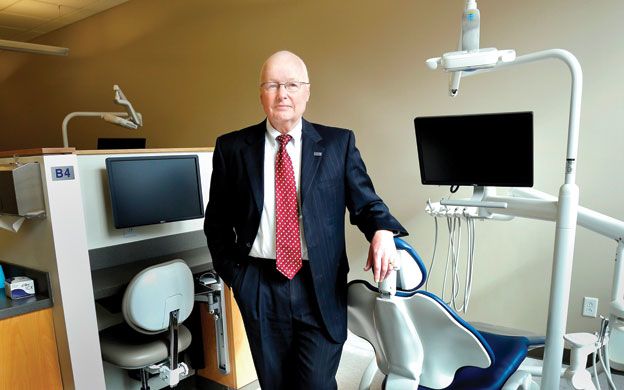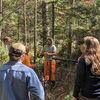With two-thirds of dentists over age 50, Maine needs reinforcements
 PHOTo / Tim Greenway
Dr. James Hanley, the new dean of UNE's College of Dental Medicine, in a student clinic in the Oral Health Center on the Portland campus.
PHOTo / Tim Greenway
Dr. James Hanley, the new dean of UNE's College of Dental Medicine, in a student clinic in the Oral Health Center on the Portland campus.
The ongoing shortage of medical professionals in rural Maine brings to mind “Northern Exposure,” the 1990s TV series focused on a New York physician's reluctant efforts to acclimate to the quirky backwoods Alaskan town where he was sent to practice medicine.
Maine continues to face worker shortages in health care, the state's largest economic sector, employing 18% of residents and providing 19% of wages paid, according to the recent 2014 Health Occupations Report from the Maine Department of Labor, Center for Workforce Research & Information. That translates into 106,000 jobs and $4.4 billion in annual payroll. The report predicts ongoing good news in terms of jobs for health care practitioners, which are expected to grow a combined 17% from 2010 to 2020.
But that also means severe worker shortages, especially in rural Maine, which has proportionately fewer health professionals per person. Registered nurses and health aids remain at the top of the list of job openings per occupation in the study, which also points to a big need to fill the hole that will be left by the large number of dentists expected to retire in the next 10 to 20 years. About 600 dentists, including those who are self-employed, were practicing in Maine in 2010, roughly the same number as in 2004. Maine's dentists tend to be older than the national norm, with two-thirds of the workforce more than 50 years old and one-third older than 60.
The report notes the need for a pipeline of practitioners to replace those who may retire in the coming years. That means the state needs to recruit and retain more than 170 dentists to fill the gap of those exiting the workforce in the next decade. Two new programs have stepped up to help fill that need.
Maine Medical Center, Tufts University School of Dental Medicine in Boston and Community Dental in southern Maine are collaborating on a one-year, postgraduate Advanced Education in General Dentistry, or AEGD, residency program scheduled to start July 1. The program, which has been accredited by the American Dental Association, initially will have three students in Maine and three in Boston. It will offer clinical training in dental care across a variety of disciplines, including pediatric dentistry and oral surgery, and include patients with special needs such as the elderly, homeless, HIV/AIDS sufferers and people with developmental disabilities. In addition, the University of New England's College of Dental Medicine, whose first class started in 2013, expects to graduate its first 64 students in 2017, including 24 who hail from Maine. The second-year class, due to start in August, has 18 of its 64 members from Maine.
Both programs aim to bring more dentists to rural and underserved areas.
That training, along with an AEGD program at the Maine VA Medical Center (Togus) in Augusta, and several dental hygienist and other supporting dental programs, is expected to slowly chip away at the gap in dentists going forward. The DOL study noted that dentists are increasing their use of hygienists, assistants and technology to see more patients and improve productivity.
“It would take 10 years to replace all of the dentists in Maine,” says Dr. James Hanley, formerly associate dean for clinical affairs at Tufts, who in April became dean of UNE's College of Dental Medicine, referring to graduates of his school and the Tufts-Maine Medical-Community Dental program [if all stayed in Maine]. “But there are 64 other dental schools in the United States, up from 57 about 10 years ago, and there are students from Maine [who will return to the state] at some of those other dental schools.” Hanley says UNE also will look at developing its own dental residency program in the future, and has no formal relationships with the Tufts-Maine Medical-Community Dental or VA programs.
He adds that the problem isn't so much the total numbers, but the distribution of dentists, that is, the concentration in urban rather than rural areas. Most of the 600 dentists are in southern Maine, he says. That agrees with figures from the DOL report, which lists a disproportionately high share of dentists relative to the population in Cumberland, Kennebec and Penobscot counties.
UNE's dental program plans to start taking patients in 2015, he says. Once the university's Oral Health Center is fully operational, faculty and students will be able to handle about 12,000 to 15,000 patient visits per year at the center plus another 20,000 to 25,000 annually in a related community-based network.
Hanley says if the students get an opportunity to study in New England and explore the region, they may fall in love with skiing or being outdoors and stay in the area to practice dentistry.
A lifestyle choice
That was the case for Dr. Myung Kim, 46, a dentist who bought the Crossway Family Dental practice in South Paris in 1998. Before that, the Tufts dental school graduate had multiple offices in Boston, but when his children were born, he wanted a simpler lifestyle.
“I'd visited Maine quite a few times, and loved the quietness,” says Kim, who grew up in California before coming to study in Boston. A friend at Harvard School of Dental Medicine recommended that Kim work in Maine, where a practice was up for sale. Kim says he initially intended to stay a couple years then leave, but fell in love with the area and the patients.
“The thing that allows me to be here is how much the patients appreciate what I do,” he says. “I get to know the patients. I like it better, and I'm happy.”
He says the thing that keeps other dentists away from Maine is not knowing the area. However, he feels the new school programs will give students a chance to learn and become familiar with the area, which he says is an attraction in itself.
Dr. Gina Terenzi, director of the new AEGD residency program, says a young dentist is likely to stay in the area where he or she did their residency training. And that's one goal of the new program: to encourage graduates to stay in a community health setting. She says the AEGD effort builds on an earlier relationship between the Tufts University School of Medicine and Maine Medical Center called the Maine Track program, which aims to attract more physicians to Maine.
The new dental residency program is funded by two grants from the U.S. Department of Health and Human Services' Health Resources and Services Administration. Residents will get about $50,000 as a salary from Maine Medical Center, but once they graduate and are practicing, their salary can bump up to $121,530 (Maine average annual starting wage).
The salaries for dentists in Maine are roughly the same as in Boston, several dentists say, though the state income tax in Maine is higher than in Massachusetts (up to 7.95% for individual Mainers compared to 5.25% in Massachusetts), which may cause some dentists to pause about locating here. There also can be pay disparities between rural and urban areas, which is why some graduates carrying $200,000 or more in student debt may hesitate to locate to rural areas, even though some have incentive payback programs, Terenzi and Hanley note.
But with some of the incentives from the federal or state government, students stand to pay back their loans more quickly, contends Lisa Kavanaugh, CEO of Community Dental, which has 12 dentists on staff at its five locations, but is based in Falmouth. Like Maine Medical Center, Community Dental also had a previous relationship with Tufts dental school, taking fourth-year students over the past seven years at its various locations to do clinical work.
“In dental school the hands-on patient care experience is limited, so with a residency they can hone their clinical skills and competencies,” she says.
Taking over
One option to help new dentists cut their teeth is either to work with an established dentist who is seeking someone to take over the practice when they retire, or simply to buy a retiring dentist's practice outright, as Kim did.
But rural dentistry poses unique challenges. Tufts dental school figures note that Maine has the lowest dentist-to-patient ratio of all the New England states, with more than 200,000 residents living in federally designated dental health professional shortage areas with fewer than one dentist per 5,000 residents. Selling a practice can be near to impossible, says Kim, who knows three retired dentists who simply had to shutter their practices because they couldn't find a buyer or an associate to take over. One such retiree had much more than a rippling effect on Kim.
“One dentist in Mechanic Falls decided to close shop and I got more than 1,500 patients [referred from that dentist],” Kim says. He eventually absorbed most of them into his practice, which now has 9,000 active patients and a staff of 12, including two dentists and another one soon to be hired.
Kim is a firm believer in residency programs, which give dentists who already graduated from a four-year program more hands-on experience, and in broader dental areas, before they take on patients. That's especially important in rural areas, where specialists may not be close by, and the dentist must know more about all aspects of dentistry.
“We see it all here, so you have to be on top of it all, to see the patient as a whole,” he says.
Adds Dr. Robert G. Bing-You, vice president for medical education at Maine Medical Center and who is involved in the dental residency program, about 25% of dental graduates want additional training to improve their skills.
“The residents are Maine Medical Center employees. They will go through a typical residency orientation along with the other [medical] residents,” he says, adding that he hopes the dental and medical residents will work together closely. He echoes Terenzi's comments that dentists and doctors are much more likely to stay in the state where they trained. He adds, however, that Maine will have to build up a pipeline of professionals over time. Meantime, he says, the state will need to keep importing dentists and doctors from other states.
Boomerang-ers
Some dentists, however, are Mainers who trained outside the state and are coming home to practice. Take Kyle Dunmire, 27, who was born in Limestone, spent his early childhood in Caribou, grew up in Oklahoma, then attended Bates College in Lewiston to get a degree in biology before studying at Tufts dental school in Boston, from which he'll graduate shortly. He is one of the students in the new AEGD residency program in Maine.
“I'm a rural person at heart,” he says. “This is an opportunity to practice where I want to. There is going to be an increased need for dental professionals in the coming years, so I'm considering staying in Maine for my career.” He says he first hopes to join another dentist's practice, and then buy out a practice that will become his own.
Meantime, he's looking forward to working with different specialists during his year-long residency in Maine. “Maine has a high population of people who don't see a dentist as much, so [the needs] are much more diverse than in a city. One reason I decided to do the residency was to be proficient in every area of dentistry. In a rural area you can't refer patients out as much.”
It remains to be seen how many of the new programs' graduates stay in Maine, and whether they can keep up with the numbers of retiring dentists. Says Kim, “Overall, there's not going to be a single solution to solving the problem.”
Read more
Primary-care practices across Maine take a new approach to help patients and reduce costs
Primary-care practices across Maine take a new approach to help patients and reduce costs
Yarmouth firm seeks to boost dental industry
Report: Maine's aging population hinders growth
Senior living facility in Scarborough to open










Comments